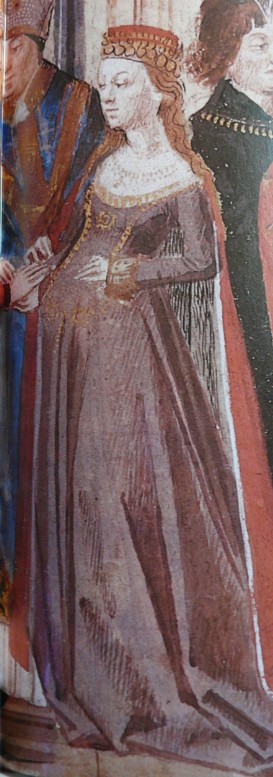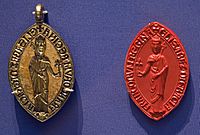Isabelle of Hainaut facts for kids
Quick facts for kids Isabelle of Hainaut |
|
|---|---|
 |
|
| Queen consort of France | |
| Tenure | 28 April 1180–15 March 1190 |
| Coronation | 28 May 1180 |
| Born | 5 April 1170 Valenciennes |
| Died | 15 March 1190 (aged 19) Paris, France |
| Burial | Basilica of St Denis |
| Spouse | Philip II of France |
| Issue | Louis VIII of France |
| House | Flanders |
| Father | Baldwin V, Count of Hainaut |
| Mother | Margaret I, Countess of Flanders |
| Religion | Roman Catholicism |
Isabella of Hainaut (5 April 1170 in Valenciennes – 15 March 1190 in Paris) was Queen of France as the first spouse of King Philip II. She was also formally a ruling countess of Artois de jure in 1180-1190.
Contents
Early life
Isabella was born in Valenciennes on 5 April 1170, the daughter of Baldwin V, Count of Hainaut, and Margaret I, Countess of Flanders. At the age of one, her father had her betrothed to Henry, the future Count of Champagne. He was the nephew of Adèle of Champagne, who was Queen of France. In 1179, both their fathers swore that they would proceed with the marriage, but her father later agreed to her marrying Philip II of France.
Queen of France
She married King Philip on 28 April 1180 at Bapaume and brought as her dowry the county of Artois. The marriage was arranged by her maternal uncle Philip, Count of Flanders, who was advisor to the King.
Isabella was crowned Queen of France at Saint Denis on 28 May 1180. As Baldwin V rightly claimed to be a descendant of Charlemagne, the chroniclers of the time saw in this marriage a union of the Carolingian and Capetian dynasties.
The wedding did not please the queen dowager, since it had meant the rejection of her nephew and the lessening of influence for her kinsmen. Though Isabella received extravagant praise from certain annalists, she failed to win Philip's affections due to her inability to provide him with an heir, though she was only 14 years old at the time.
Meanwhile, King Philip in 1184, was waging war against Flanders, and angered at seeing his wife's father, Baldwin, support his enemies, he called a council at Sens for the purpose of repudiating her. According to Gislebert of Mons, Isabella then appeared barefooted and dressed as a penitent in the town's churches and thus gained the sympathy of the people. Her appeals angered them so much that they went to the palace and started shouting loud enough to be heard inside.
Robert, the king's uncle, successfully interposed and no repudiation followed as repudiating her would also have meant the loss of Artois to the French crown. Finally, on 5 September 1187, she gave birth to the needed heir, the future King Louis VIII of France.
Death

Her second pregnancy was extremely difficult; on 14 March 1190, Isabella gave birth to twin boys named Robert and Philip. Due to complications in childbirth, Isabella died the next day, and was buried in the cathedral of Notre Dame in Paris. She was not quite 20 years old and was mourned for greatly in the capital, since she had been a popular queen.
The twins lived only four days, both having died on 18 March 1190. Her son Louis succeeded her as Count of Artois. Isabella's dowry of Artois eventually returned to the French Crown following the death of King Philip, when her son Louis became king.
See also
 In Spanish: Isabel de Henao para niños
In Spanish: Isabel de Henao para niños


